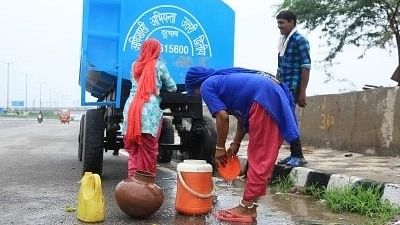New Delhi: The Aam Aadmi Party government in Delhi may be on an announcement spree months ahead of the assembly elections, but Chief Minister Arvind Kejriwal appears to have realised that his government has failed on its promise to provide piped drinking water to all households.
A day after Prime Minister Narendra Modi delivered a message to conserve water, Kejriwal Tuesday said the Delhi cabinet has decided to make rainwater harvesting compulsory in all government buildings. He also said that his government has come up with mechanisms to make the city “self-sufficient” to meet its water demands.
The heads of government departments have been directed to install systems for rainwater harvesting before the arrival of the monsoon, he said.
Responding to a question on the government’s failure to meet people’s water needs, a promise that was made in AAP’s 2014 manifesto, Kejriwal said: “We have been making efforts for the past four years. Everything cannot be done in the first year itself.
“The Delhi government has cleared an ambitious project for water conservation in the Yamuna floodplains too. We want to bring an end to water shortage in the capital.”
Water will be conserved in stretches from Palla to Wazirabad using eco-friendly measures. The CM also said the project would be built at an estimated cost of Rs 50 crore. A five-member committee, which has been formed for the land acquisition process, is likely to give its report next week.
The Delhi government will require approval from central government agencies to go ahead with the project after a decision is made by the cabinet. According to sources, Union Jal Shakti Minister Gajendra Singh Shekhawat has already been informed about it.
Also read: As Chennai water woes mount, here’s the audit report Tamil Nadu govt wanted buried
The pilot project
The Yamuna enters Delhi near Palla village after traversing a route of about 224 km. The Palla well field in the Yamuna floodplain is a perennial source of water supply, especially to north Delhi. But severe groundwater depletion has reduced water availability in the capital, especially during the lean months — April to June.
Several studies conducted by National Institute of Hydrology and IIT-Delhi have laid emphasis on the high recharge potential of the Yamuna floodplain.
The aim of this pilot project is to conserve excess flood water during the monsoon, and use it to recharge the sub-soil ground water.
According to government officials, steps have already been taken to conduct a detailed conceptual and technical study to ascertain the feasibility of creating shallow reservoirs/ water bodies on the Yamuna flood plains — between the river’s natural course in the non-monsoon seasons and its ‘Right Marginal Embankment’.
Also read: Like Swachh Bharat, Modi wants mission Save Water. Stop free water first




Few years back a bold statement from the then Govt. claimed that Delhi has underground water reserves for 40 years from Muradnagar, hope this is true, or may be a झुमला , but this is a reminder of the severe water crisis we shall face in the next 1 or 2 years.
It’s not difficult to make these calculations. First ask the question: if Delhi gets 1000mm of rain per year, what does it mean? Use Google. Then scale it to 1000 sq ft. It’s a lot of water. And the water that goes underground is not necessarily stored in tanks. It charges the groundwater. So the area feels the benifit, not just the building.
Can ThePrint come out with a detailed article explaining rainwater harvesting in government buildings? The article may base the details on a real government building and then explain the current water consumption in that building and what part of this consumption would be met by the harvested rain water, what is the size of storage container that will store the rain water and how much rain water can be collected from a 1000 squire feet of building top’s area? The article should answer many such questions.